By Gunsmith Barry B. Snell
This article gives you a step-by-step pictorial how-to guide on removing a AR 15 A2 Front Sight.
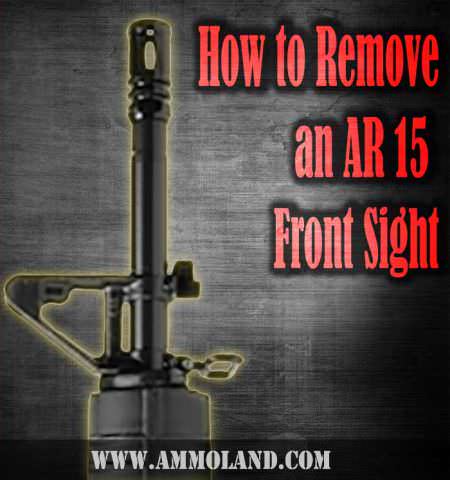
USA – It’s a familiar, all-American story: You bought a basic AR-15 rifle awhile back and it came with the classic triangular-shaped fixed front sight base pinned onto the barrel.
You’ve been shooting it and your rifle works fine, but you keep seeing these cool ARs on the Internet, with the free float handguard tubes and other accessories, and you’re starting to think that maybe it’s time to mod your gun too. The boys and girls down at the range can’t have a cooler AR-15 than you do, after all.
Well, I have good news: No, you do not need to take your AR rifle to a gunsmith to get the fixed front sight off, and yes, you can do all these steps yourself.
How do I remove an AR 15 rifle front sight post?
To remove an AR15 A2 front sight you remove the handguard, remove the flash hider, loosen the gas tube, then remove the front sight base pins. Follow these illustrated how-to steps, below, on removing a AR 15 A2 front sight. This gunsmithing process generally takes less than one hour to complete.
Step 1: Remove the AR Rifle Handguards
If you have a non-standard handguard installed on your AR-15, such as a free-float tube, you may be able to skip this step if removing your handguard also requires removing the front sight base first. However, if you have the standard two-piece handguards on your AR-15, you’ll need to remove them, and now’s the time. Grab your handy dandy Brownells AR-15 handguard removal tool (SKU #080-000-487WB):
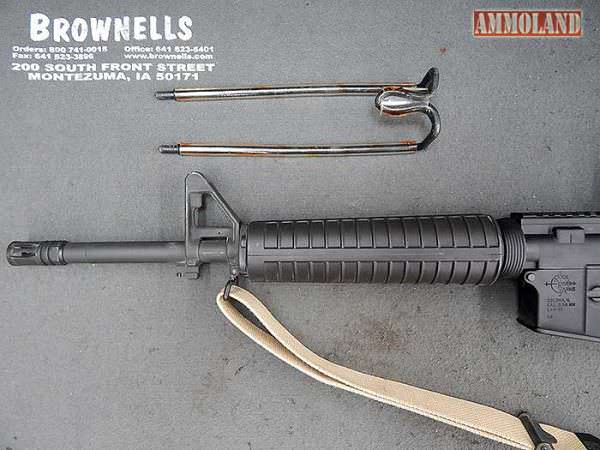
Place the “hook” of the handguard tool into the front of the mag well, and slip the “arms” along the sides of the delta ring.
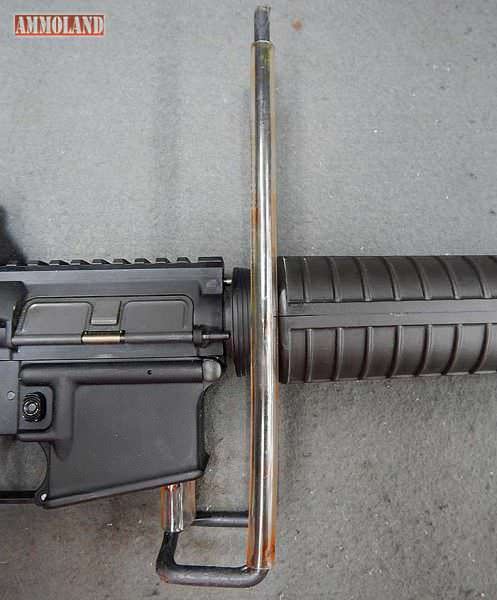
Now pull the arms of the handguard tool back, towards the rear of the rifle, thus compressing the delta ring spring and allowing the rear of the handguard halves to move freely outward.
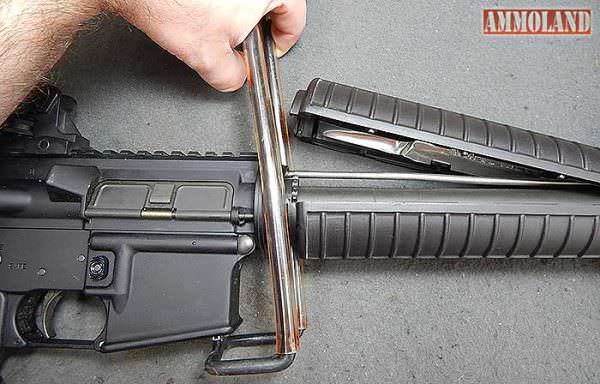
Step 2: Clamp Upper AR-15 Rifle Assembly Into Vise
You’ll need to get your AR-15’s upper half clamped into a vise, so you can remove the flash hider. Flash hiders are typically installed with a cupped crush washer that puts forward tension on the flash hider, which prevents it from unscrewing while you shoot. Because of this sprung crush washer, a good bit of torque is typically required to install the flash hider and get it aligned and clocked properly, therefore requiring some kind of clamping mechanism to hold the upper secure so you can wrench on the flash hider during removal.
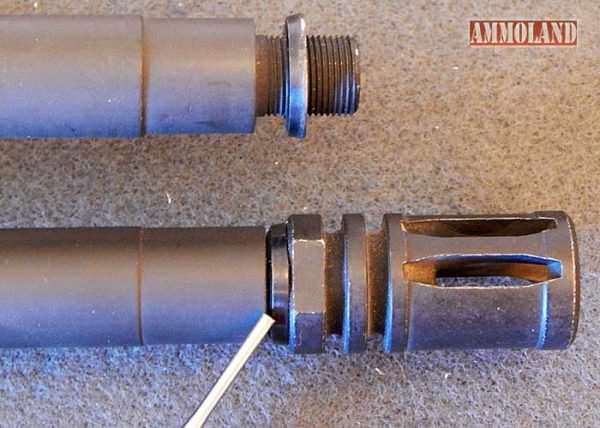
Thankfully, Brownells’ AR-15 action vise block set (SKU #080-000-659WB) makes it an easy task while removing a AR 15 A2 front sight. To use it, you need to remove the upper half of your AR-15 from the lower half, then remove any rear sights, carry handles, or optics you have installed.
Then, remove the bolt carrier and charging handle and replace them with the Brownells action insert, included with the AR-15 action vise block set. The Brownells action insert provides some internal structural support for your upper receiver when it’s squeezed tightly in your vise, preventing it from being crushed or deformed.
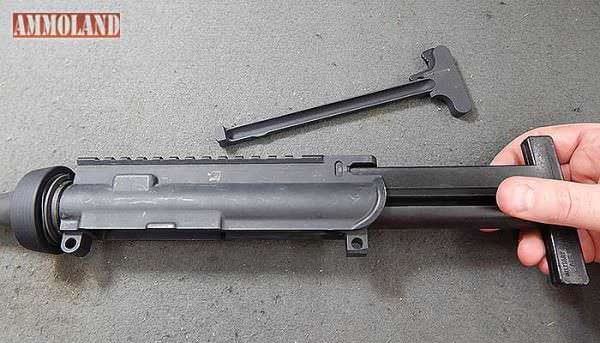
Now place your upper receiver into the vise block itself. The vise block is milled out to fit the receiver’s contours exactly, so the first time you use it you’ll probably have to wiggle it around a little to find the right spot. It will only close completely once you’ve got it set right.
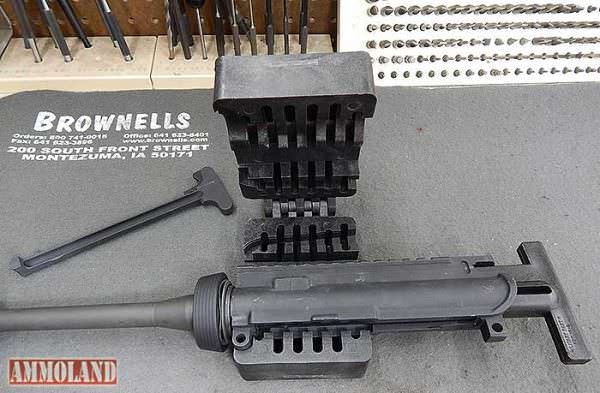
Now close the action block up and clamp the whole assembly into your bench vise.
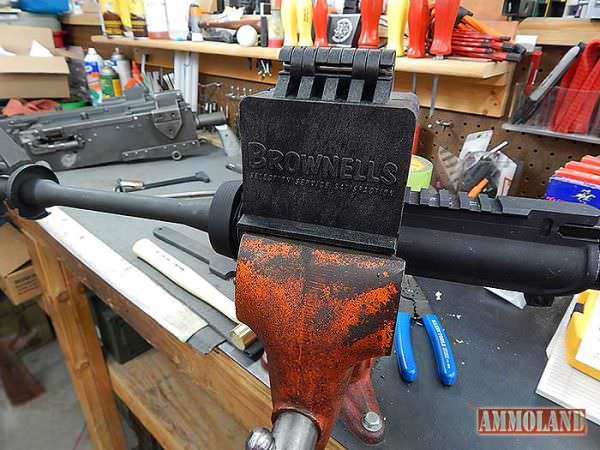
Step 3: Remove Your AR 15 Rifle Flash Hider
Grab your Brownells AR-15 armorer’s wrench (SKU #080-001-208WB), place the jaws on the flats on the side of the flash hider, and unscrew it. Remember righty tighty, lefty loosey!
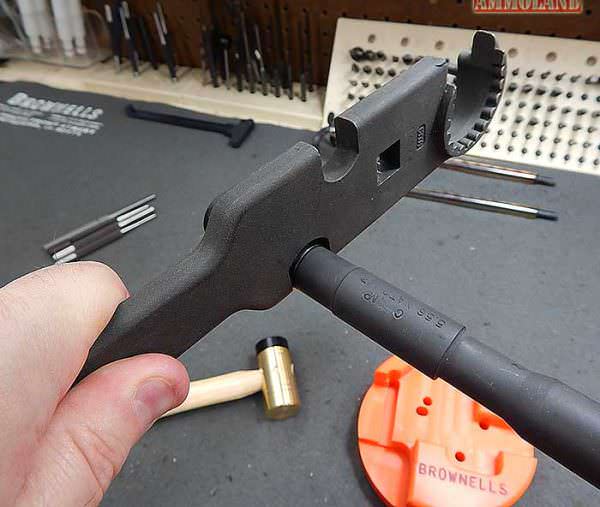
Step 4: Remove the AR 15 Rifle Gas Tube
Before we can remove the front sight base, we have to disconnect it from the gas tube. Only one tiny little roll pin is all that stands between you and front sight freedom, so place your barrel in the Brownells front sight bench block (SKU #080-000-252WB), and grab your #2 roll pin punch (SKU #230-100-002WB) and derlin tipped brass hammer (SKU #080-001-220WB).
A couple notes are necessary here. First, be sure to use the special roll pin punch if you can, because using a standard flat tipped punch can deform the end of your roll pin and ruin it (if you do damage it, no big deal replacement roll pins are available). The special #2 roll pin punch has a little nub on the tip that fits inside the roll pin and prevents the edges from squashing inward as you hit it with a hammer.
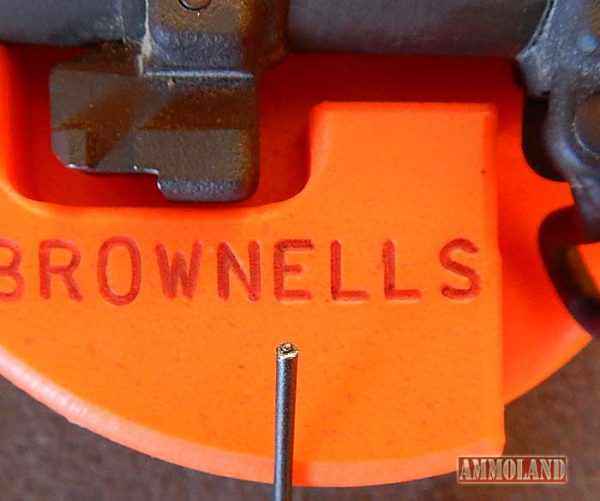
Second, be sure to use a brass or plastic hammer to hit your punches in the upcoming steps.
Yeah, I know you’ve got a perfectly good steel claw hammer ready to do the work of removing an AR 15 A2 front sight, and buying a new brass hammer seems like a waste of money. But there’s a darn good reason every gunsmith worth their salt has brass and plastic hammers at hand: Hitting a hardened steel punch with a hardened steel hammer can cause one or both to chip or even explode like a grenade. We all know that Murphy’s Law says that the final resting place of those little steel chips flying around at 200 mph will be in your eyeball. So let’s just agree to reduce the chance of that happening, and go on ahead and buy that brass hammer—but don’t forget to wear those safety glasses! The brass hammer only reduces the risk, it doesn’t eliminate it completely!
Lastly, let’s take a closer look at that fancy Brownells front sight bench block. Remember what I said at the beginning about the tapered and straight tapered pins while removing a AR 15 A2 front sight? Well, the old standard pins will have a taper, meaning that they go in only one way and come out the other way. So when you take your barreled upper out of the vise and action block and place it in your front sight bench block, notice that it has a “PINS OUT” side and a “PINS IN” side. You’ll also notice that the bench block is machined out specifically to fit the front sight block, so your barrel will only fit in one way.
This is because the good folks at Brownells made their front sight bench block to be directional too, just like the pins, which makes it almost impossible to screw up the pin removal. Genius, eh?
Now, I’ll admit, the gas tube roll pin is not directional like the front sight block taper pins are, but it is good practice to always knock it out and put it back in the same way. So lay the bench block down with the “PINS OUT” side facing up, and place your barrel in with the muzzle to the left so it fits in the machined space, correctly.
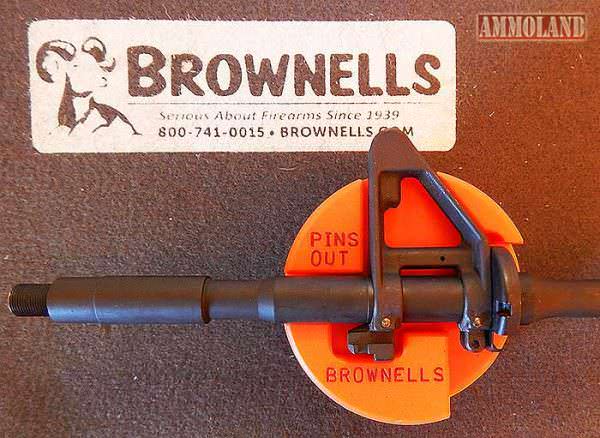
Place the #2 roll pin punch in the gas tube roll pin, taking care to ensure it is centered and the little nub on the tip is seated firmly inside the hollow center of the roll pin.
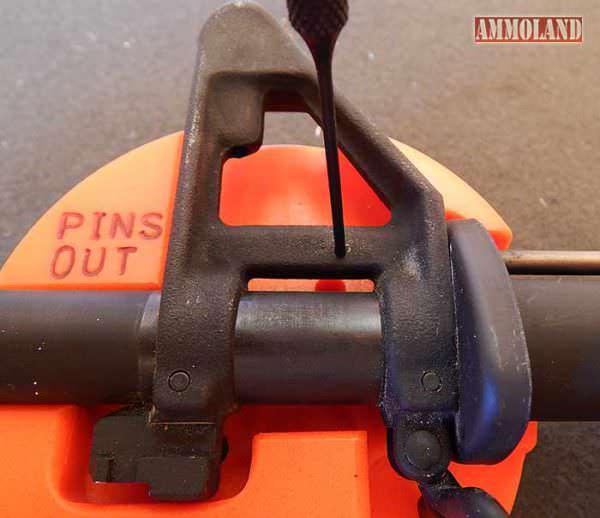
Give the punch a few firm hits with your brass hammer. It shouldn’t take a lot of force to get the gas tube pin moving, so don’t go full beast mode on the little guy.
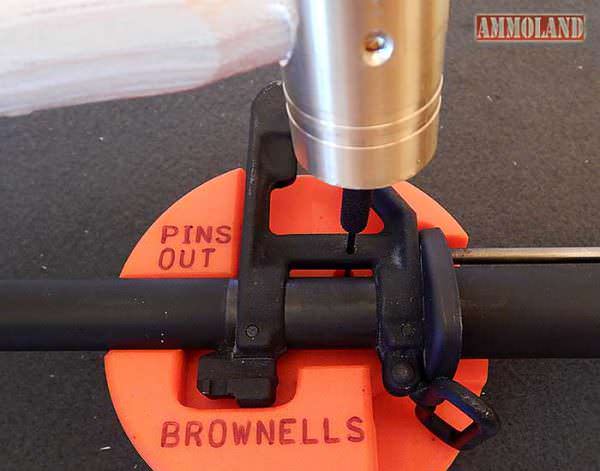
And just like that, the little gas tube roll pin drops out.
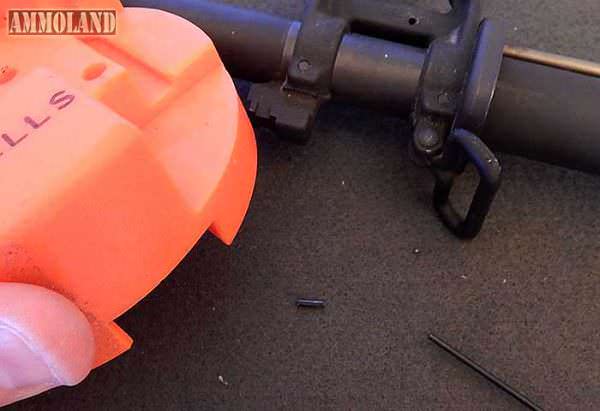
Once the gas tube roll pin is knocked out, you may find that your gas tube is now loose and you can pull it back out of the AR 15 A2 front sight base.
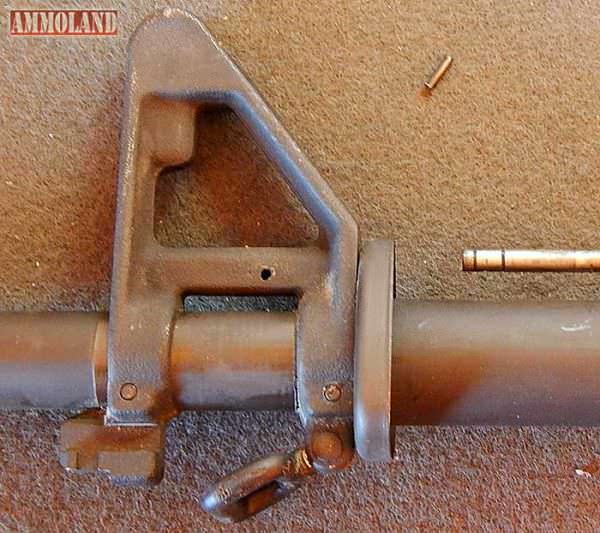
If your gas tube is free, you can carefully wiggle it out the back of your upper receiver and remove it and set it aside to keep it from accidental damage in the next steps. You may find, however, that your gas tube won’t move; the carbon fouling from shooting can glue it in there pretty well. No worries if it won’t budge though. It’ll come loose when you pull the front sight base off the front of the barrel.
If it won’t move, leave it be. Do not get a pair of pliers and yank it out! You’ll probably crush your gas tube and end up back on Brownells.com with credit card in hand again.
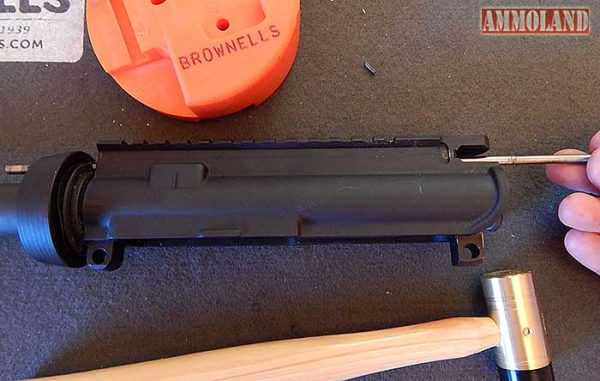
Step 5: Remove the Ar15 Rifle Front Sight Base Pins
Now it’s time to get down to the main event in removing a AR 15 A2 front sight! Double-check to make sure you’ve got your bench block with the “PINS OUT” side still facing up, and lay your barrel back in. Grab your punch and hammer, and prepare to knock the pins out.
(NOTE: there are two (2) types of pins in the front sight block review this part of the article before proceeding)
You may find it useful at this time to place your upper receiver back in the vise block to support that end of the barreled assembly while you hammer on the other end. This will prevent your upper from bouncing around and make the procedure go a little smoother.
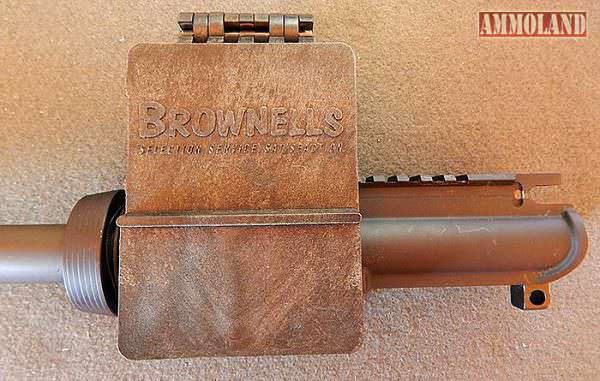
If your front sight base has the round headpins, make sure you use the taper pin starter punch with the “dished” tip. This will prevent deforming the head of the pin while you smack it with a hammer. Likewise, if your front sight base has flat headpins, you’ll want to use a flat-tipped punch.
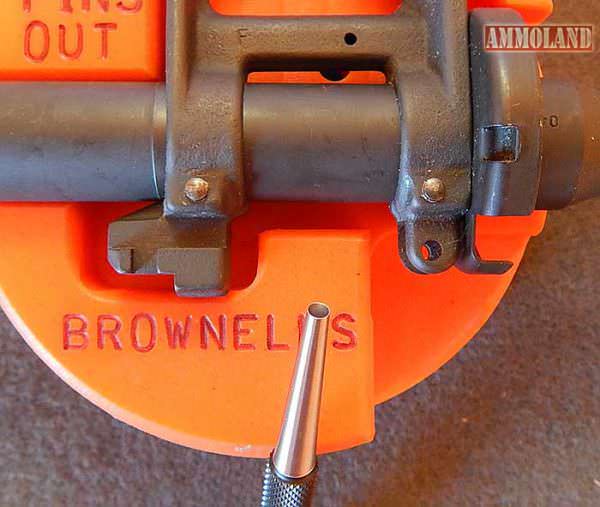
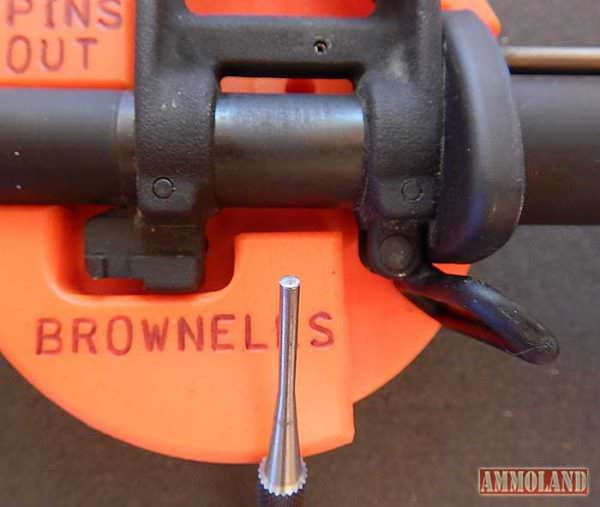
Place the appropriate punch on the head of the pin, carefully centering it to keep from hammering the pin into the front sight base itself. Keep the punch completely vertical, then begin to give it a few good, firm hits squarely on the base of the punch, driving all the force directly down into the pin. It will probably take more force to remove these taper pins than it did for the gas tube roll pin, but it still shouldn’t require any feats of superhuman strength either.
If the tapered tip of the punch itself prevents it from driving the taper pin all the way out, just pull that punch out and follow it up with the flat-tipped 3/32” punch. It won’t take much to shove the pin the rest of the way through, so there’s no risk of damaging the head of the pin at this point. Just tap it lightly with your hammer.
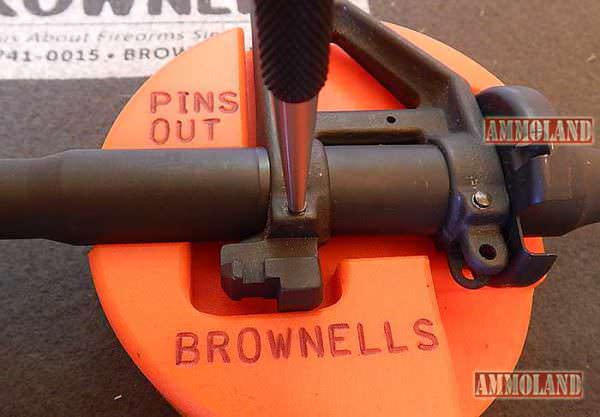
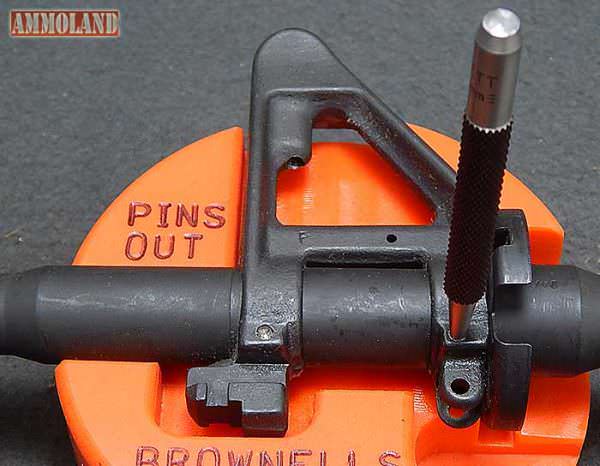
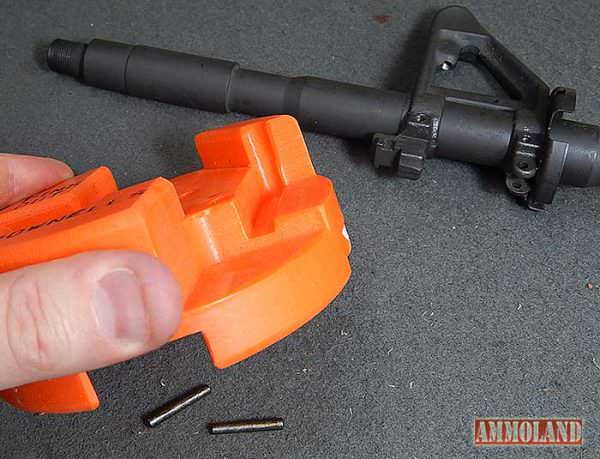
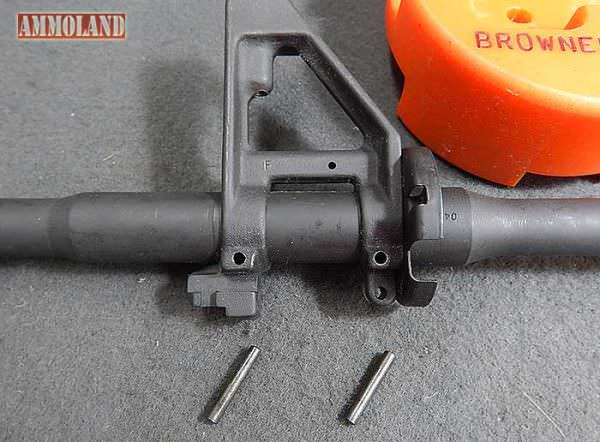
Even though you shouldn’t have any trouble knocking these pins out, tolerance stacking sometimes means we get a pin a couple ten thousandths too thick, but it’s still within tolerance, and it was pressed into a hole a couple ten thousandths too small, that likewise is still within tolerance. Further, not all gun companies and gun parts are created equal; there’s a reason some cost more than others, and manufacturing precision and quality control usually come at a price. Also, if whoever assembled your rifle used tapered pins and installed them backward, you may encounter difficulty as well.
If it seems like the pins aren’t moving and you’re just beating it to death, stop what you’re doing, take a breath, and investigate before you damage something.
Do you have the punch centered and pointed straight up and down, or are you off-center and smashing the sight base at the edge of the hole instead? Are you hammering on a firm surface? If you’re working on the kitchen table and everything is bouncing around like popcorn in a skittle when you strike the punch, you’re losing a lot of energy into your work surface. If you don’t have a good, solid work surface, try moving to the floor or your concrete driveway or sidewalk out front. The more mass beneath the bench block, the better!
A trick I’ve found that can help is to put a little Kroil Oil or other penetrating oil on the head of the pins. Just apply a little dab and let it sit for a couple of minutes while you calm down and the urge to cuss and throw your pretty new brass hammer subsides. This is also an instance where, yes, a heavier hammer can help to remove a AR 15 A2 front sight if you’ve got one. Sometimes hitting a punch a bit lighter with a heavier hammer is more effective than hitting harder with a light hammer. It’s because of all that physics stuff from high school that you forgot.
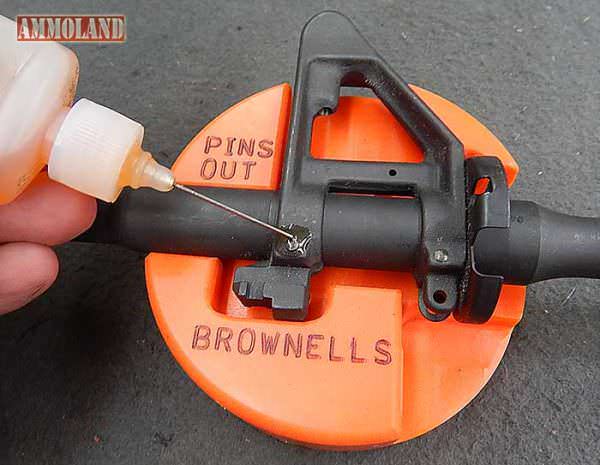
Step 6: Removing a AR 15 A2 Front Sight – Remove the Ar15 Rifle Front Sight from the Barrel
Once you’ve got all the pins driven out of the front sight base, it is free to move forward and off the end of your barrel. How hard the removal is depends entirely on your rifle. It could be as simple as just grabbing it and giving it a bit of a twist, and off it comes in your hand, easy peasy. Or, you could have to hit it with a hammer and drive it off the end. Between the gobs of front sight bases I’ve swapped for Uncle Sam and my own rifles over the years, I’ve encountered both ends of the spectrum and everything in between while removing a AR 15 A2 front sight.
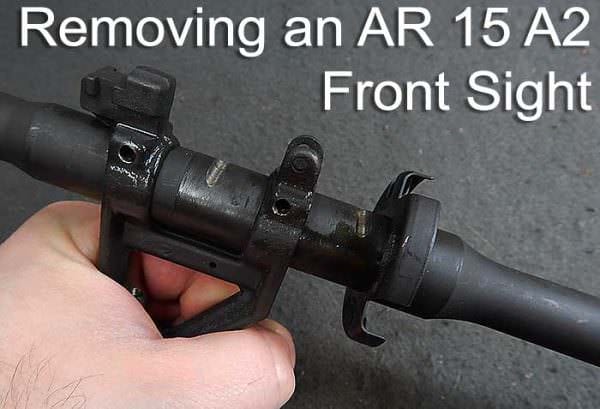
If you have to apply force to the front sight base to convince it to move, apply that force judiciously. Up-end your barrel so you can hit the front sight base from behind, but be sure to protect the muzzle by placing it on a non-marring surface that won’t gall or damage it. Hold your barrel firmly and carefully rap the flat spot on the back of the front sight base with a soft hammer. A plastic-faced hammer is preferred as shown here, however, brass will work; it will just leave brass marks that will need to be cleaned off later.
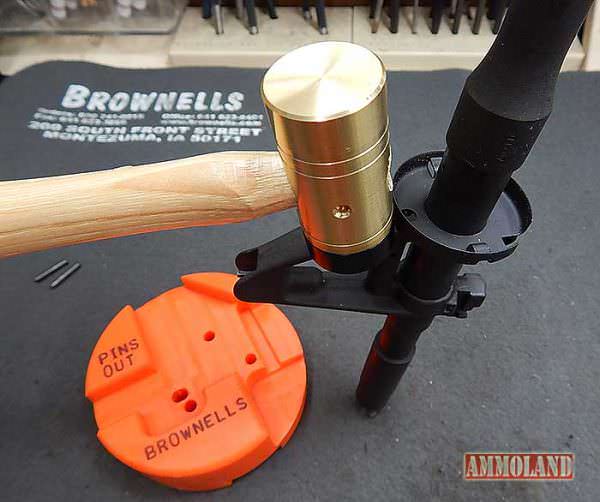
After you’re rewarded with that sudden jolt as the front sight base finally overcomes friction and pops loose, you should be left with something that looks like this:
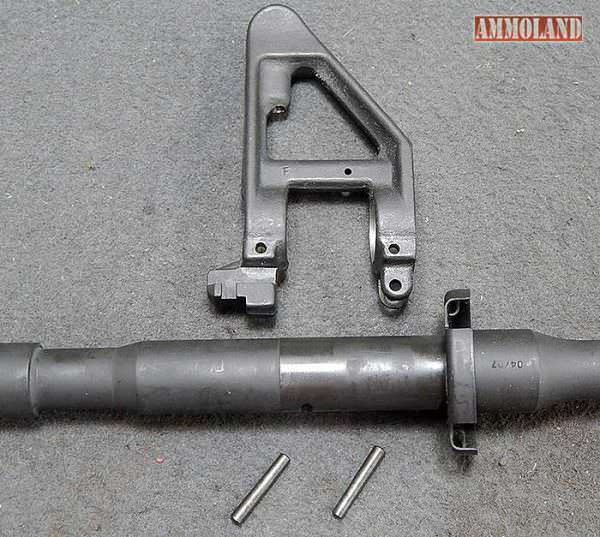
Ar 15 Rifle Gas Port Comments
Now you’re free to install a new gas block, put that cool ultra-lightweight free-floating tube on, or whatever it is you’re up to. Just be sure to follow the manufacturer’s instructions for the new part, and you should be golden. Before you install a new gas block though (or the old one for that matter), I recommend inspecting the gas port first, which is that little hole on the top of the barrel. This is where the gas escapes behind the bullet after it’s been fired, and rushes back down the gas tube into the receiver, cycling your bolt carrier.
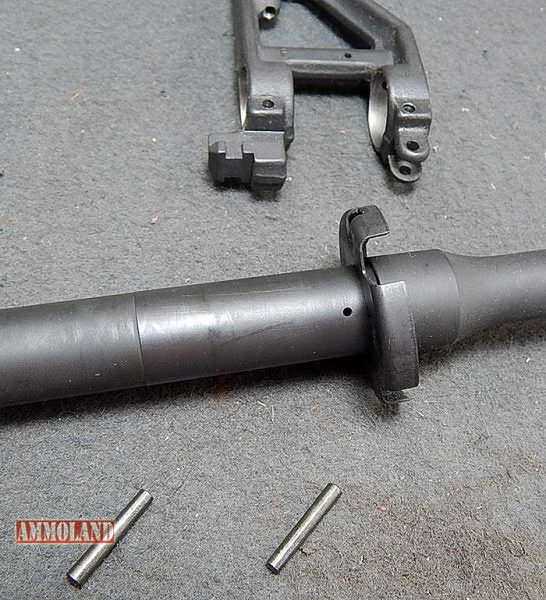
As you shoot, the gas port will erode over time. This erosion is caused by the repeated rush of high temperature, high-pressure gas blasting through this hole. Mil-spec for an M4 Carbine gas port diameter is 0.063”, or 1/16”, and the M16 Rifle gas port spec is 0.093”, or 3/32”. Other manufacturers will have different specs, which they should be able to tell you.
There are pin gauges you can get to measure your gas port, however it’s really not necessary unless you’re a gun geek like I am, or you build ARs professionally and you require perfection.
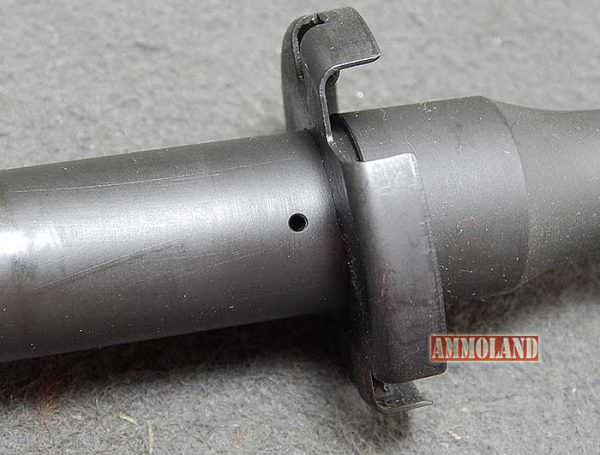
The main thing is simply to see if anything looks unusual. Use your common sense: Is there excessive-looking flash cutting on one edge of the hole or another? Is the port going ovular? Is it totally misshapen? Does it look more like a dished-out crater than a neatly drilled hole? Does the area around the gas port look super filthy and crusty? All of these things could mean something, or they could mean absolutely nothing except maybe your barrel is getting old or perhaps you use a suppressor a lot. It’s just a data point to keep an eye on if something seems amiss. If you start having mysterious malfunctions, knowing your gas port was looking a bit funky last time you saw it might bump checking it out higher up the troubleshooting list.
Bare AR-15 Barrel Steel
Lastly, you may discover that removing a AR 15 A2 front sight base leaves two shiny bands of bare barrel steel behind. This is because some companies parkerize their barrels after the front sight base has been installed. The problem is merely cosmetic, however, you’ll still want to provide some protective finish to the exposed steel as a rust preventative.
The best thing of course would be to remove the barrel entirely and send it off to a gunsmith to be reparkerized. If that’s not an option though, you could always get a can of Brownells Aluma-Hyde and apply a couple of coats. Cerakoting is another option and will be the most durable over time, but Cerakote also comes at the highest cost and application difficulty. Or, if you’re not worried about any small color differences, then I’d recommend a quick application of Brownells Oxpho-Blue. Oxpho-Blue cold bluing has been used by gunsmiths for decades for touch-up jobs just like this one, and it will serve you well too. Just tape off the area around the bare metal so you don’t get the Oxpho-Blue on the parkerizing, and follow the instructions on the label. There’s nothing to it!
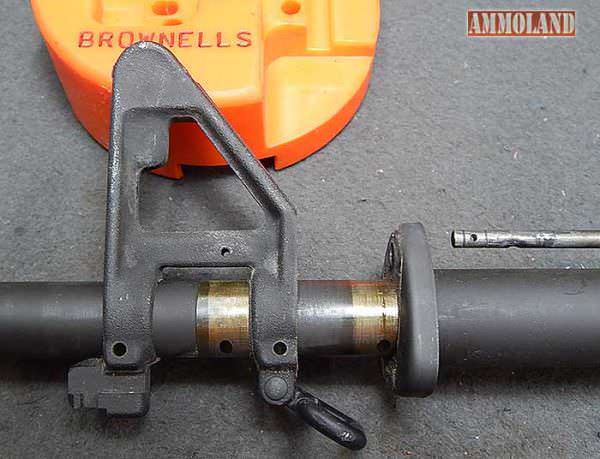
Well, folks, that’s it! You successfully completed all the steps in removing a AR 15 A2 front sight Class dismissed. Best of luck on your AR-15 black rifle project!
Safety, Front Site Pins Types & Tools For the Job
Safety.
Since you’re going to be taking a firearm apart, make sure you’ve properly unloaded and cleared your AR first, and remove the ammunition from the room so there’s no mix-ups. Once you’ve made sure your AR rifle is unloaded, check it again, and then check it once more. Guns don’t suffer fools, and we’re going to be dealing with the business end for this project, so don’t become a news headline the antis can use against the rest of us.
Then, when you’re gathering together the tools you’ll need, grab your safety glasses too. You’ll be hitting hardened steel punches with a hammer, which has been known to result in some high-speed flying shards of metal on occasion. Furthermore, you’ll be hitting little steel pins with those punches too, and it’s not hard to send those things flying.
Tools for Removing a AR 15 A2 Front Sight
So aside from the safety glasses, what tools will you need for the task?
You won’t need much, so this is a very budget-friendly project. I’ve seen people grind down a nail to make an impromptu, ersatz punch and use their big 30 ounce Estwing framing hammer to drive it. That’ll certainly work in a pinch and I’d be a liar if I said thousands of ARs all across America hadn’t been successfully shade tree gunsmithed in just this way, but as usual, just a few specialty tools will prevent accidents, do the job better, make your life easier, and produce a better-finished result.
There’s getting the job done, and there’s getting the job done right, right? Besides, modifying AR-15s is addictive, so trust me: You’ll use these tools again and again!
Head on over to my friends at Brownells.com, “THE source for all your gunsmithing needs”, and check out these specialty tools (note: these links and SKUs are valid at the time of writing but may change).
Gunsmith Tools You Will Need:
- Brownells front sight bench block (SKU #080-000-252WB)
- Brownells derlin tipped brass hammer (SKU #080-001-220WB)
- Brownells AR-15 armorer’s wrench (SKU #080-001-208WB)
- Brownells AR-15 action vise block set (SKU #080-000-659WB)
- Brownells AR-15 handguard removal tool (SKU #080-000-487WB), or the required wrenches or tools if you have a non-standard handguard that requires removal to take the front sight base off
- Brownells #2 roll pin punch (SKU #230-100-002WB)
Then, if you have round head taper pins holding your front sight base on, you’ll want the following punches:
- Starrett taper pin starter (SKU #827-530-320WB)
- Starrett 3/32” pin punch (SKU #827-525-790WB) If you have flat head pins holding your front sight base on, all you’ll need is the 3/32” pin punch.
AR 15 A2 Front Sight Pin Types
How do you know if you’re got round head or flat head taper pins?
Easy. Just look closely at the two pins holding your front sight base onto your barrel, and see whether they have a rounded head or a flat head. They look like this:
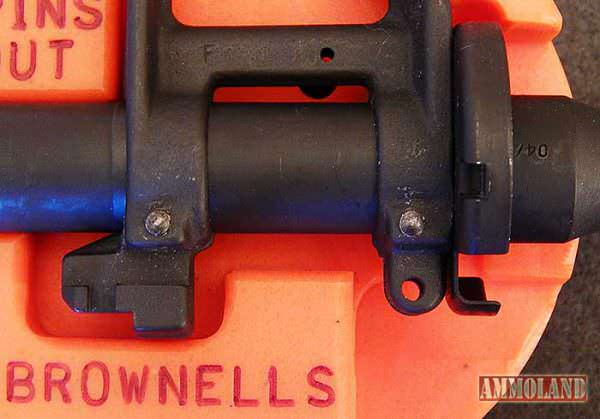
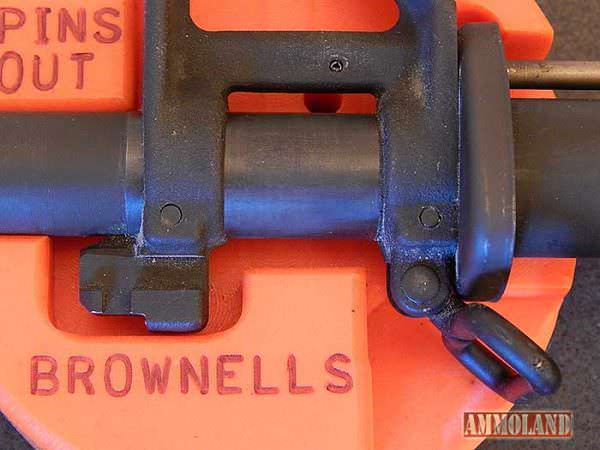
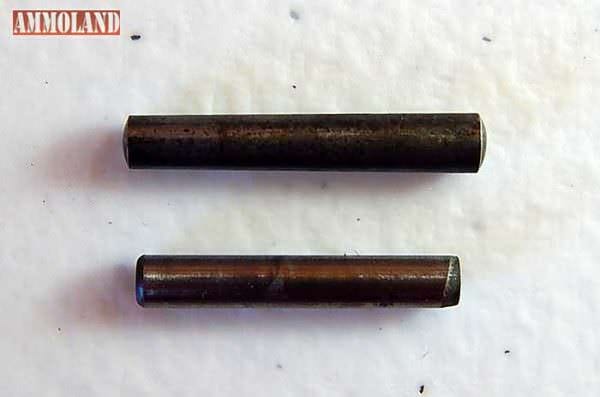
Note that the round headpin on the top of Figure 3 has a very slight taper, with the narrow end to the left and the thicker end to the right. The flathead pin on the bottom has a straight taper.
The top style pin used to be the specification for military rifles and they were what I was familiar with as a small arms repairman for the Army’s Colts, FNs and LMTs. However I’m told that this has changed, and military contractors are now shipping rifles with straight taper pins in the front sight bases. This certainly appears to be the case for the rifles those contractors are selling on the civilian market.
Both types of front sight pins work just fine and there’s no reason to be concerned if you have one or the other. The difference is noticed when installing or removing the pins, as the tapered pins have the potential to be easier to work with due to the taper. However, if they’re accidentally installed backward, they can be a real nightmare to deal with. If the military specification has indeed changed, this would be why; straight taper pins can’t be put in backward, and any downside of needing extra force to install or remove them is compensated for by not being able to screw them up.
Moral of the story: Pay attention to your pins, and remove and install them appropriately!
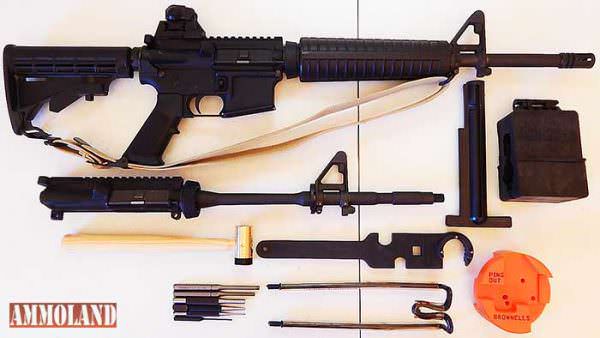
The image above is the collection of the tools and items used for this project—and no, you don’t need two ARs. I just used the two here because they each have the different front sight base pins, shown above. Unless noted, all the steps are identical regardless of the rifle used for the photograph.
Click here to return to the beginning of the Step by Step Guide.
About Barry B. Snell
Barry Snell is the executive director and lobbyist for the Iowa Firearms Coalition, Iowa’s most effective Second Amendment advocacy group, whose legislative victories include legalizing suppressors and making Iowa a Shall Issue state. Barry is also a part-time gunsmith for Controlled Chaos Arms, an 07 FFL/03 SOT in Baxter, Iowa, and a contributing author for Brownell’s publications.
